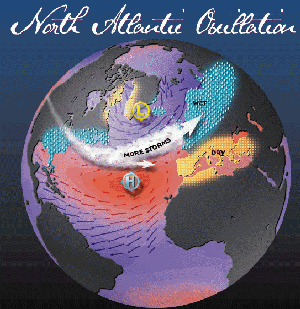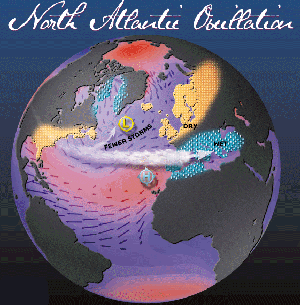 > ENC Master > Climate Encyclopaedia > Weather > more > 2. Major wind systems > - NAO
> ENC Master > Climate Encyclopaedia > Weather > more > 2. Major wind systems > - NAO
 |
|
|
|
WeatherMore |
NAONorth Atlantic Oscillation (NAO) Climate variability comprises three primary, but interrelated phenomena in the North Atlantic region: the Tropical Atlantic Variability, the North Atlantic Oscillation and the Atlantic Meridional Overturning Circulation. The NAO is a fluctuation in a sea level pressure difference between the Iclandic Low and the Azores High. The name was first cited by Walker G.T. in 1924.
|
|
The history of the NAO The history of the NAO is quite long: missionary Hans Egede Saabye made observation in his diary already in 1770-78: ’When the winter in Denmark was severe, as we perceive it, the winter in Greenland in its manner was mild, and conversely.’ Simultaneously, coherent fluctuations in temperatures, rainfall and sea level pressure were documented, reaching eastwards to central Europe, southwards to subtropical West Africa and westward to North America. The fluctuations of NAO influence climate from North America to Siberia and from the Arctic Ocean to the equator.
The strength of the NAO is described by the NAO index. The NAO index is the difference of sea-level pressure between two stations situated close to the centres of Iclandic Low and Azores High. Stykkisholmur (Iceland) is used as the northern station, whereas either Ponta Delgada (Azores), Lisbon (Portugal) or Gibraltar are used as the southern station. Such a simple index clearly cannot take account of possibility that the centres of the actual pattern may not overlap with these locations, nor can it accurately capture the seasonal variations in the NAO. However, there is a key advantage to the use of such an index because the existing weather records allow it to be extended back in time to at least 1864. When the index is correlated or regressed with gridded surface pressure data, the resulting north-south dipole pattern defines the spatial pattern of NAO.
|
The negative NAO index phase shows a weak subtropical high and a weak Icelandic low. The reduced pressure gradient results in fewer and weaker crossing on a more west-east pathway. They bring moist air into the Mediterranean and cold air outbreaks and hence snowy weather conditions. Greenland, however, will have milder winter temperatures. The low index winter/springs of 1917, 1936, 1963, and 1969 had weaker mean westerlies over the North Atlantic Ocean with corresponding colder than normal European winters. |
|
|
|
 |
|
3. source: http://www.ldeo.columbia.edu/res/pi/NAO/ |
|
|
About this page:author: Sándor Szalai - Hungarian Meteorological Service |
|
References:http://www.met.rdg.ac.uk/cag/NAOMarshall, J. et al., 2001: Nort Atlantic climate variability: phenomena, impacts and mechanisms. Int’l Journal of Climatology, 1863-1898 pp.
|


